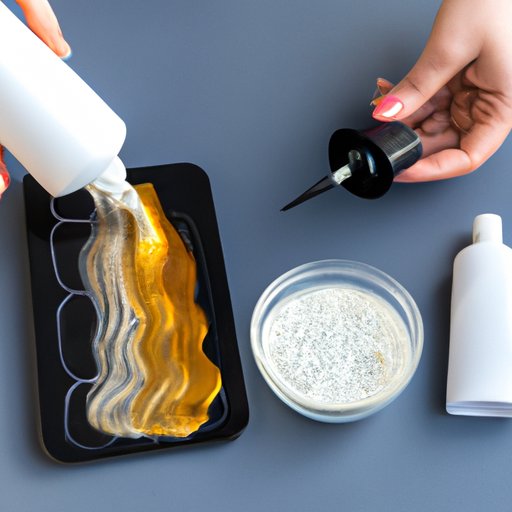Introduction
Hair bleaching is a chemical process that lightens hair by removing its natural pigment. It’s a popular way to create dramatic new looks, from bright platinum blonde to subtle highlights. When done correctly, hair bleaching can be a safe and effective way to change up your style. But if done too frequently, it can cause serious damage to your hair and scalp.
Different Methods for Bleaching Hair Safely and Effectively
There are several different ways to bleach your hair, ranging from DIY solutions to professional services. The method you choose should depend on the desired results, as well as your budget and the condition of your hair.
Permanent vs. semi-permanent bleaches
Permanent bleaches contain powerful oxidizing agents, such as hydrogen peroxide, that strip away the natural pigments in your hair, resulting in a much lighter shade than you started with. Semi-permanent bleaches, on the other hand, use milder ingredients that merely lighten existing color, rather than completely changing it.
Homemade bleach recipes
You can also make homemade bleaches using natural ingredients such as lemon juice, honey, and chamomile tea. These all-natural solutions are gentler than store-bought bleaches and may be more suitable for those with sensitive scalps. However, they won’t achieve the same level of lightening as a permanent or semi-permanent bleach.
Professional bleaching services
If you want to achieve a dramatic color change, you may want to consider getting a professional bleaching service. Professional stylists have the experience and knowledge to achieve the exact look you’re going for, while minimizing the risk of damage to your hair. Of course, this option is typically more expensive than doing it yourself.

Effects of Frequent Bleaching on Hair Health
Frequent bleaching can have a number of negative effects on your hair health. Here are some of the most common issues associated with over-bleaching:
Damage to hair cuticles
The hair cuticle is the outermost layer of your hair shaft and it serves to protect the inner layers. When exposed to strong chemicals, the hair cuticle can become damaged, leaving the inner layers of your hair vulnerable to breakage and split ends.
Potential scalp irritation
Frequent bleaching can also irritate the scalp. If you notice any burning, itching, or redness after bleaching, stop immediately and seek medical attention.
Color fading
Repeated bleaching will eventually take its toll on your hair color. Over time, the color can become patchy and uneven, and may even turn brassy or greenish. To avoid this, wait at least four weeks between bleaching sessions.

How Often Is Too Often to Bleach Hair
It’s generally recommended to wait at least four weeks between bleaching sessions. This gives your hair enough time to recover from the previous bleaching session before being exposed to the chemicals again. However, this timeline may vary depending on the type of bleach you’re using and the condition of your hair.
Recommended frequency of bleaching
If you’re using a permanent bleach, you should wait at least six weeks between bleaching sessions. For semi-permanent bleaches, you can wait four to six weeks. And if you’re using a homemade bleach recipe, you can wait three to four weeks between bleaching sessions.
Factors to consider when bleaching hair
When deciding how often to bleach your hair, there are a few factors to consider:
- Your hair type – Fine or thin hair may require less frequent bleaching than thicker hair.
- The condition of your hair – If your hair is already dry or damaged, you should wait longer between bleaching sessions.
- The type of bleach you’re using – Permanent bleaches tend to be harsher than semi-permanent bleaches.
- The desired result – If you’re aiming for a dramatic color change, you may need to bleach more frequently.

Benefits of Bleaching Hair Less Frequently
Bleaching your hair less often has a number of benefits for your hair health, including:
Improved hair health
By limiting the amount of time your hair is exposed to the chemicals in bleach, you can reduce the amount of damage caused by the bleaching process. This can help keep your hair healthy and strong, while also improving its overall appearance and texture.
Reduced damage to hair
Limiting the amount of time your hair is exposed to bleach can also help minimize the amount of damage it sustains over time. This can help keep your hair looking and feeling its best.
Longer lasting color
By not over-bleaching your hair, you can ensure that the color lasts longer. This means you won’t have to worry about your hair fading or becoming patchy between bleaching sessions.
Conclusion
Bleaching your hair can be a great way to switch up your look. However, it’s important to be aware of the potential risks associated with frequent bleaching, including damage to your hair and scalp. To get the most out of your bleaching sessions, it’s important to understand how often you should bleach your hair, as well as the different methods available. By following these guidelines, you can enjoy all the benefits of bleaching without sacrificing the health of your hair.


